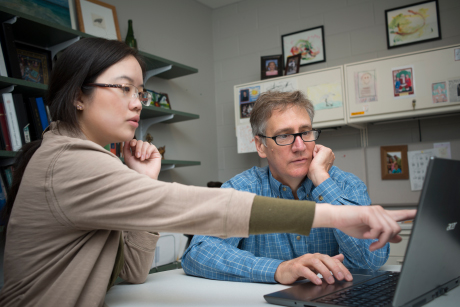Gene linked to development of skin cancer in mice
By Merry R. Buckley

New research on an enzyme linked to cancer development shows that 37 percent of mice that produce excessive quantities of the enzyme developed skin tumors within four to 12 months of birth, and many of these growths progressed to highly invasive squamous cell carcinoma, a common form of skin cancer.
This finding, published online Sept. 11 in the journal Cancer Research, provides the first genetic link between the activity of the enzyme, called PAD2, and cancer progression, and provides important supporting evidence for further studies aimed at using PAD2 inhibitors to block carcinoma progression in humans.
Lead author Scott Coonrod, the Judy Wilpon Associate Professor of Cancer Biology at the Baker Institute for Animal Health in Cornell’s College of Veterinary Medicine, has studied links between PAD2 and other PAD (peptidylarginine deiminase) enzymes and cancer for some time. Those prior studies suggested that PAD2 plays an important role in regulating genes during cancer progression; however, a direct link between PADs and tumor progression had not yet been proven. Other work from the lab suggested that PAD2 is found at high concentrations in several tumor types, but it was not known whether these elevated levels of the enzyme were causing cancer or merely a consequence of tumor progression.
To directly test for links between PAD2 and cancer, the researchers engineered mice to overexpress PAD2 and then looked to see whether these mice developed cancer.
Coonrod thinks that the reason PAD2 overproduction in the skin may cause cancer is likely due to its ability to promote inflammation.
“Inflammation has long been known to play an important role in the development of many types of cancer,” he says. “Recent studies provide strong evidence that inflammation represents one of the 10 hallmarks of cancer.“It’s becoming clear that the activity of PAD enzymes seems to be low in most normal tissues, but becomes elevated in a whole range of inflammatory diseases – like rheumatoid arthritis, colitis and lupus. PAD activity is very high in the affected tissues and seems to be driving a lot of the inflammatory conditions that cause these diseases.”
To test whether PAD2 might be promoting inflammation, Coonrod and his colleagues looked for classical markers of inflammation in the growths and found that a number of these markers were significantly elevated in the mouse tumors. To further test their hypothesis, they overexpressed PAD2 in human cell lines to better understand how the enzyme might behave in human tissue. They found that, similar to the mouse studies, PAD2 overproduction made these human cells more invasive and also enhanced inflammatory marker expression.
Together, these studies suggest that increased PAD activity in human skin, and potentially other tissues, promotes an inflammatory environment that is favorable for cancer development, says Coonrod. His longtime collaborator, Paul Thompson at the University of Massachusetts Memorial Medical Center, has developed a range of new PAD inhibitors, and the team is now testing whether these compounds might suppress carcinoma progression in mouse models of both skin and mammary glands.
Two of Coonrod’s co-authors on the paper, “PAD2 Overexpression in Transgenic Mice Promotes Spontaneous Skin Neoplasia,” are postdoctoral associate John McElwee, Ph.D. ’13, and graduate student Sunish Mohanan, DVM, who carried out some of the research for their thesis projects in Coonrod’s lab.
Merry R. Buckley is education and outreach program coordinator for the Baker Institute for Animal Health.
Media Contact
Get Cornell news delivered right to your inbox.
Subscribe